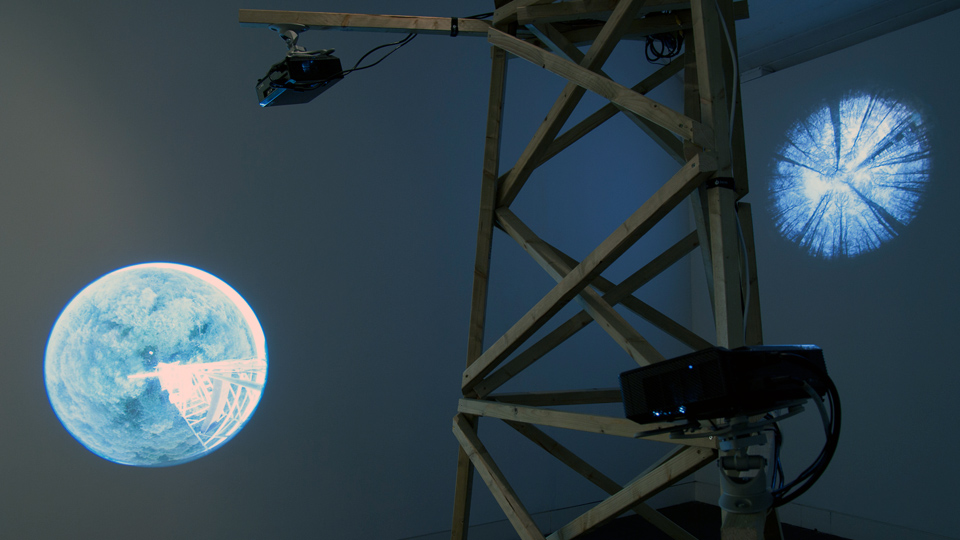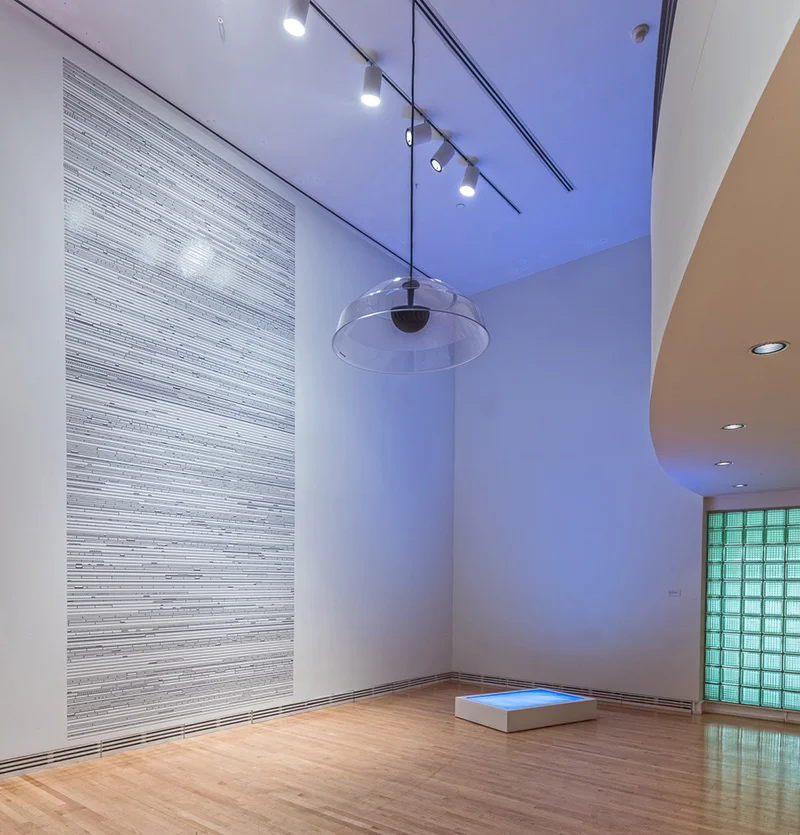Catching the Light
Installation still. Image: artist website.
It is challenging to accept how little we will ever see of our world, particularly the space beyond Earth’s atmosphere. What we do see is curated by organizations in such a way that it becomes nearly impossible to form one’s own opinion of the beauty and power of the realm of stars and otherworldly planets. Artist duo Semiconductor’s Catching the Light makes this complex notion tangible, while attempting to help viewers see just how mediated our view of the beyond is. This 2014 installation was originally commissioned by and displayed at the Art Science Museum in Singapore with the help of data and imagery from the Mikulski Archive for Space Telescopes (MAST).
Semiconductor’s work sits neatly at the intersection of art and science, an unfamiliar territory for most people, just like the content they choose to portray. Ruth Jarman and Joe Gerhardt are the team behind the name. For Catching the Light, they took thousands of images from MAST’s database and pieced them together to create a time-lapse-style film. The installation was almost 20 feet wide and consists of several selectively placed screens hanging on the wall, each with their own unique shape and surface. With the help of programmer Julian Weaver, the artists stitched together satellite images of nebulae, stars, and deep space to create a seamless, flowing composition. (Alexander Scholz, Creative Applications)
The series of images is projected onto the screens in a film-like manner. The screens were hung in a dark room, creating an immersive atmosphere for viewers to enter and watch the images of lights and space flow and flicker across the otherwise midnight black colored screens. Like glimmering stars on a partly cloudy evening, the images seem to go in and out of focus and view, periodically extinguishing completely to blanket the entire room in a deep darkness. Accompanying the images is a dissonant and generative soundtrack that responds to their brightness. The organized yet cacophonic sounds have a metallic quality, and are reminiscent of noises born of radio waves that have been translated into a somewhat harmonic composition. As the images shift, the sounds change in clarity and tone, adding to the installation's mesmeric qualities.
Jarman and Gerhardt artfully combined the otherwise data-based images of stars and galaxies to portray a view of the world not often seen by the average person. The images from MAST still have numerical data points on them, but the artists chose not to edit these out to show just how mediated our view of this part of the universe is. On Creative Applications, writer Alexander Scholz acknowledges this decision:
“By embracing the artifacts of image capturing technology—noise, anomalies, errors—the artists emphasize the source data’s distinct aesthetics and remind us that our view of the natural world is largely framed by the tools and processes of science.”
With such an indirect impact on what aspects of space are presented to us, how can we really form our own opinion of what is beyond the human realm? Catching the Light’s fractured screens and flickering imagery portrays the gaps and fragments that pervade our view of nature. While they might have only chosen to show images of space, the representation could easily apply to other elements of nature of which our view is limited.
This installation is not the only work by Semiconductor to address how we interpret scientific and organic data via external sources. Data Projector was made in collaboration with the Jerwood Open Forest and exhibited at the Jerwood Space in London, England in 2015.
Installation view. Image: artist website.
Similar to how Catching the Light portrayed nature via a distant lens, this installation shows mediated views of forests and aerial images of other natural habitats. The darkened room is centered upon a makeshift structure that resembles an observation or electrical tower. Hanging from it are projectors, which show evolving circular representations of nature on the walls surrounding it.
The projections show time lapse-style images of the forest's cycle, just as the collaged portrait of stars was depicted in Catching the Light. Jarman and Gerhardt note on their website of the piece:
“...there’s also a precision which comes with the data, bringing structure and rhythm and creating a sense of complexity to what we see and hear. This conversation between analogue and digital plays with the divide between how science represents nature and how we experience it.”
From Alucore to wood, and natural imagery via digital lenses, the artists have successfully combined both manmade and natural materials to represent these intangible concepts in both installations. By "humanizing" the data, they help us view the world from a different perspective while highlighting the fact that this perspective is not our own, and illustrating the important role we play as spectators in appreciating what makes it possible for us to view and comprehend our surroundings. Another artist taking the concept of 'humanizing' data and exploiting how we view nature is Hanna Husberg, a Finnish artist who works in Sweden.
Her 2016 work, In the vast ocean of air invokes similar ideas but in an entirely different geographic region of the earth: the icy landscape of the Artic.
Installation view. Image: artist website
As opposed to focusing on stars, this piece focuses on the transformations and transmutations of clouds. In one corner of the installation, a looped video presents viewers with aerial and other views of clouds in Svalbard, an island in the Arctic. Surrounding it are neon signs that depict modern icons for temperature settings that can be found on machinery such as air conditioners. The artist chose to focus on this region due to it's historically exploited resources, and emphasizes their exploitation with the manmade icons that are presented surrounding it. The similarity here lies in the footage she uses of the Arctic, which is also sourced from others via ships and towers, highlighting how our view of even this region that is more accessible than outer space is produced by the infrastructure with which we've invaded it in order to take advantage of its resources like gas and oil.
Both projects present distinct yet similar ideas about the distance between us and our impact on and view of our environment. Whether in space or in the Arctic, humans are making their mark and forming judgements about regions of which they know little.
Links
- http://semiconductorfilms.com/art/catchingthelight/
- https://creators.vice.com/en_us/article/semiconductors-new-installation-is-a-portal-into-the-cosmos






